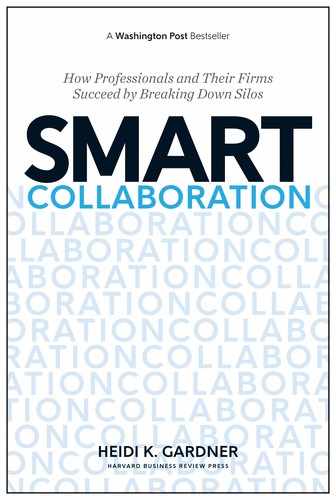16SMART COLLABORATION
My hope is that many readers will find all four of these role-
specific chapters interesting and useful—even the chapters that speak
explicitly to the needs of a different constituency from their own.
Certainly, a firm’s senior leaders benefit from knowing what makes
those coming up behind them tick. Equally important, those
younger people who aspire to move up the ladder should know
why the boss acts the way he or she does—especially on the crucial
ground of collaboration.
Chapter 7 explores how the lessons and prescriptions in this
book apply to complex organizations well outside the perimeter of
professional service firms: Do fundamental truths about collabora-
tion apply more broadly?
My answer—which grows out of an in-depth study of a world-
class medical research and health care institute—is yes. Although
doctors and research scientists are very different from lawyers,
architects, management consultants, and executive-search part-
ners in some regards, many parallels are clear: they are all highly
trained, specialized experts—often with egos to match. They con-
trol critical, portable resources (grants for academics resemble cli-
ent relationships for partners). They’ve got reputations they want
to protect, whether as principal investigator on a high-profile,
nationally funded study or guru adviser to a renowned CEO. The
academic tenure track resembles the partnership promotion pro-
cess at many professional firms.
Not surprisingly, then, you see some similar patterns across all
these walks of professional life. Are there obstacles to senior-level
collaboration in this rarified context? Yes. Are there personal and
institutional advantages to overcoming those obstacles? Again, yes.
Chapter 8 reinforces the third perspective: that of the client. The
voice of the client surfaces throughout the book, but it’s especially
pronounced in this final chapter.
One of the most rewarding aspects of my research in recent
years has been synching up the perspectives of the professional ser-
vice firms in which I’ve spent most of my time with the views of
the clients those firms tend to serve. What do clients see when their
service providers arrive in teams—helpful collaboration, or costly
churning? The answers may surprise you.
Introduction.indd 16 06/10/16 12:06 am
Introduction17
Leaders make collaboration happen
I’ll close this introduction by speaking directly to the leader of an
ambitious, knowledge-based firm who finds him- or herself reading
these pages.
Promoting collaboration to benefit your firm is your responsibil-
ity. To achieve that end, you have to understand the perspectives
of your partners (and future partners), and shape your strategy
accordingly. If your high-performing professionals are not collab-
orating effectively today, it’s surely not because they’re stupid or
obstinate; it’s often because you are holding them to the kinds of
short-term metrics that work against collaboration. Investments in
collaboration take time to bear fruit, and you and your leadership
team are the only ones who have the authority to demand (and
reward) institutional patience.
You—ideally in close collaboration with your senior leadership
team—are also the only people with the authority to make the
necessary interventions to kick-start a more collaborative approach
on the partner level, and then to sustain that approach with sub-
sequent interventions that are well timed and well crafted. Those
interventions are described at the appropriate times in the relevant
chapters.
Be forewarned, though: when it comes to fostering stronger,
more efficient, more reliable collaboration within your organiza-
tion, there is no “silver bullet.” The prescriptions in this book are
only the starting point for developing a highly tailored, custom-
ized strategy that fits your firm’s challenges. My prescriptions are a
practical and informed point of departure for shaping a multidisci-
plinary solution to your complex organizational problem—which
is, in fact, the same thing your clients need from you.
The firm may not be burning down, but there’s definitely the smell
of smoke in the air. Given the lead time that is required to build
an organization and a culture to foster collaboration, you have no
choice but to start right now. Should you choose to go down that
road, this book provides you with a map for getting there.
Introduction.indd 17 06/10/16 12:06 am
Introduction.indd 18 06/10/16 12:06 am
..................Content has been hidden....................
You can't read the all page of ebook, please click here login for view all page.
